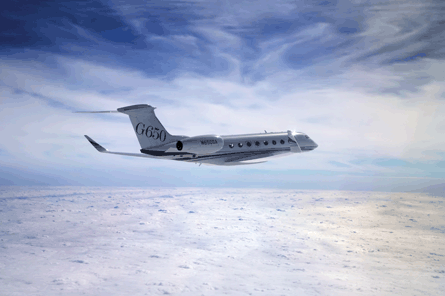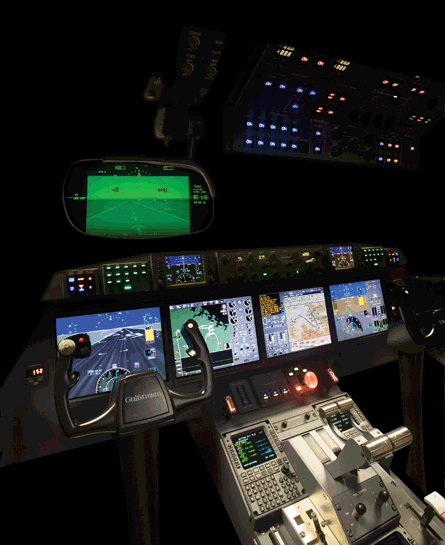Gulfstream has a slight problem in the flight testing department when it comes to its newest ultra-long-range jet: it needs a faster chase aircraft.
Pres Henne, senior vice-president of programmes, engineering and test for the Savannah, Georgia-based airframer, tells the story of a recent test flight in which the company's official chase aircraft, the first Gulfstream V (serial number 501), was attempting to keep up with the first G650.
Test aircraft 1, aka T1, is tagged as serial number 6001, indicating the first new type certificate for the company since the start of the Gulfstream II line in the early 1960s. The $60 million, 13,000km (7,000nm)-range business jet is scheduled for certification in 2011 and first deliveries in 2012. The test programme includes three test aircraft (T1-T3), two production-representative models (P1, P2) as well as a static (S6) and fatigue (F6) test airframe.
 |
|---|
© GulfstreamStreaking ahead: the Gulfstream G650 |
"We were chasing 6001 with 501," says Henne. "We started at Mach 0.85. The GV does that great since its MMO [maximum operating speed] is M0.885.We got to M.875, and the GV was able to keep up. When 6001 pushed up to M0.9, the GV pilots tried everything to make it go faster, even switching to "alternative mode" on FADEC to redline the engines."
But it was all for nought. "The 6001 just walked away from them. It's clearly got the speed built into it, and pretty soon we'll be up to M0.925 or higher," Henne adds.
Through a combination of a clean-sheet wing design, two Rolls-Royce BR725 turbofans that each deliver 16,000lb of thrust (71.6kN) and a host of other factors, Gulfstream is promising a cruise speed of M0.925, one-half of 1% greater than that of today's fastest business jet, the M0.92 MMO Cessna Citation X.
The honour of having the fastest aircraft has been a long-standing point of contention between the two companies, with Cessna promising to match or beat the G650's top speed if need be.
PUSH FOR SPEED
Along with a push for higher speeds and envelope expansion for T1, test aircraft T2 (6002) is now a member of the programme and its focus is on systems functionality, including environmental control and hydraulics. T3 (6003) is being instrumented for the test programme and is expected to begin flying in early May, with its primary function to be a testbed for the aircraft's Honeywell Primus Epic-based PlaneView II flightdeck.
The fourth aircraft, dubbed P1 (first production aircraft), is undergoing engine run tests and should fly by the end of May, says Henne. P1 will get a full interior at Gulfstream's facility in Savannah before returning to the flightline for cabin systems testing.
The G650's cabin, which includes pressurisation for a 4,850ft (1,480m) cabin at FL510 or a 2,800ft cabin at FL410, is designed to be fail operational, meaning no single-point failure can result in a loss of cabin functionality. P2, the fifth aircraft, will be used primarily for reduced vertical separation testing.
 |
|---|
© GulfstreamGulfstream is quiet on what type of aircraft it will use to chase T1 as it enters the a cruise regime beyond that any other Gulfstream aircraft can catch it |
As of 27 April, Gulfstream had logged more than 130h in 45 flights on T1 since its first flight in November, and five flights and 11h in T2 since its first flight in February. After receiving "heavy instrumentation", T2 was scheduled to fly to Eglin AFB in Florida for several weeks of hot and cold temperature environmental chamber testing in the base's McKinley Climatic Laboratory.
Pilots and engineers are flying a series of flight-control parameter identification tests with T1, part of the stability and control verification programme, says Henne. To date, the aircraft has flown for as long as 6h, been as high as FL480 and as fast as M0.90, using nose boom and trailing cone devices for airspeed measurements.
Henne says static source error correction data gained during the tests is in the process of being incorporated into the flightdeck software, a step which will allow the test team to use the production airspeed system for measurements. Airspeed calibration tests included several days of 340kt (630km/h) tower passes in Brunswick, Georgia, says Henne.
Once the static source error correction is embedded, Henne says pilots will continue to expand the flight envelope, starting with stability and control tests using additional fly-by-wire modes. The G650 is the company's first fully fly-by-wire aircraft.
Pilots to date have been using "first flight" FBW mode, which uses angle-of-attack as a measure of performance and is usually used at low altitudes. "Normal" control mode, next in line for testing, uses g-loads as the measure of performance for the closed loop control system. Other FBW modes include direct, alternate mode and failure mode.
"We flew [g-load FBW mode] on serial number 632, our advanced flight controls demo vehicle," says Henne. Aircraft 632 is a Gulfstream V (N532SP). "We decided up and away that g-load is the control that gives best capability for the aircraft," he adds.
Other tests completed include engine handling, ram air turbine deployment, landing gear loading, and several flight envelope corners including maximum gross weight operations at the forward centre-of-gravity limit.
 |
|---|
© GulfstreamInside the Gulfstream V's cockpit |
Henne says stall characteristics have been "better than expected" at all flap settings. Given that the wings, with 33° of sweep at the quarter-chord point, have 6° more sweep than the GV, there was some concern that one wing would stall before other, leading to a pronounced roll-off at stall.
"If anything, it's improved over the GV," says Henne, attributing the desirable response to computational fluid dynamics work that went into the wing design. "The aero guys spent a great deal of time optimising the wing."
Henne says the team will complete flutter testing "in the very near" future, which will allow maximum speed tests to begin. Much of the confidence in the structural performance of the aircraft has come from a full slate of envelop limit tests performed on the static test airframe, S6. Henne says fatigue testing using F6 should start in the third quarter this year in the structural test hangar, following the completion of the static tests there.
Gulfstream is quiet on what type of aircraft it will use to chase T1 as it enters the a cruise regime beyond that any other Gulfstream aircraft can catch it. When asked, the company responded with a curt but intriguing, "no comment". My bet is a Cessna Citation X.
- All the latest news, images and video from EBACE 2010
Source: Flight Daily News























